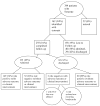Predicting adverse outcomes in syncope
- PMID: 17976548
- PMCID: PMC2276584
- DOI: 10.1016/j.jemermed.2007.04.001
Predicting adverse outcomes in syncope
Abstract
Syncope is a common presentation to the Emergency Department (ED); however, appropriate management and indications for hospitalization remain an ongoing challenge. The objective of this study was to determine if a predefined decision rule could accurately identify patients with syncope likely to have an adverse outcome or critical intervention. A prospective, observational, cohort study was conducted of consecutive ED patients aged 18 years or older presenting with syncope. A clinical decision rule was developed a priori to identify patients at risk if they met any of the following 8 criteria: 1) Signs and symptoms of acute coronary syndrome; 2) Signs of conduction disease; 3) Worrisome cardiac history; 4) Valvular heart disease by history or physical examination; 5) Family history of sudden death; 6) Persistent abnormal vital signs in the ED; 7) Volume depletion; 8) Primary central nervous system event. The primary outcome was either a critical intervention or an adverse outcome within 30 days. Among 362 patients enrolled with syncope, 293 (81%) patients completed their 30-day follow-up. Of these, 201 (69%) were admitted. There were 68 patients (23%) who had either a critical intervention or adverse outcome. The rule identified 66/68 patients who met the outcome for a sensitivity of 97% (95% confidence interval 93-100%) and specificity of 62% (56-69%). This pathway may be useful in identifying patients with syncope who are likely to have adverse outcome or critical interventions. Implementation and multicenter validation is needed before widespread application.
Figures
References
-
- Kapoor WN. Evaluation and outcome of patients with syncope. Medicine. 1990;69:160–74. - PubMed
-
- Sun BC, Emond JA, Camargo CA., Jr Direct medical costs of syncope-related hospitalizations in the United States. Am J Cardiol. 2005;95:668–71. - PubMed
-
- Beth Israel Deaconess Medical Center Institutional Review, October 1, 2001–January 31, 2002. Boston, MA: Beth Israel Deaconess Medical Center;
-
- Nyman JA, Krahn AD, Bland PC, Griffiths S, Manda V. The costs of recurrent syncope of unknown origin in elderly patients. Pacing Clin Electrophysiol. 1999;22:1386–94. - PubMed
-
- Kapoor WN. Evaluation and management of the patient with syncope. JAMA. 1992;268:2553–60. - PubMed
MeSH terms
Grants and funding
LinkOut - more resources
Full Text Sources
Medical
Miscellaneous



